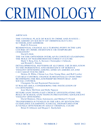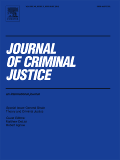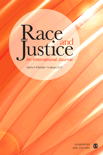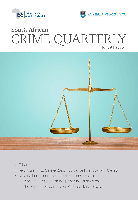
CRIMINOLOGY
Scope & Guideline
Exploring the Complexities of Law and Forensic Medicine.
Introduction
Aims and Scopes
- Crime and Social Inequality:
A core focus on how crime intersects with social inequalities, particularly concerning race, ethnicity, and socioeconomic status. This includes studies on racial disparities in arrests, sentencing, and victimization. - Policing and Community Relations:
Research examining the dynamics between law enforcement and communities, including perceptions of police legitimacy, community policing strategies, and the impacts of police actions on different demographic groups. - Mental Health and Criminal Behavior:
Explorations into the psychological aspects of crime, particularly how mental health issues affect both offenders and victims, and the implications for correctional practices. - Gang Dynamics and Disengagement:
An emphasis on understanding gang culture, the processes of disengagement from gangs, and the social and health impacts of gang involvement on individuals and communities. - Legal and Policy Implications:
Critical evaluations of legal frameworks, policies, and their effects on crime rates and recidivism, including discussions on financial obligations, incarceration, and rehabilitation. - Urban Crime and Environmental Factors:
Investigations into how urban environments, community structures, and public spaces influence crime rates and patterns, emphasizing the role of neighborhood characteristics.
Trending and Emerging
- Racial Disparities and Justice Reform:
An increasing number of publications focus on racial disparities within the criminal justice system, including studies on police interactions, sentencing disparities, and systemic racism, highlighting the need for reform. - Impact of Mental Health on Criminal Justice:
Research on the intersection of mental health and criminal justice is gaining prominence, particularly regarding the treatment of mental health issues among offenders and the implications for policy and practice. - Community Engagement and Crime Prevention:
There is a growing emphasis on community-oriented approaches to crime prevention, exploring how community engagement and local resources can effectively address crime and enhance public safety. - The Role of Technology in Crime:
New themes surrounding the impact of technology on crime, including the use of social media in criminal behavior, cybercrime, and the role of technology in policing, are emerging as significant areas of research. - Effects of Economic Factors on Crime:
The relationship between economic conditions and crime rates, including studies on unemployment, economic inequality, and their roles in shaping criminal behavior, is increasingly being explored.
Declining or Waning
- Traditional Theories of Crime:
There has been a noticeable decrease in research centered around classical criminological theories, such as strain theory and routine activity theory, as newer frameworks and interdisciplinary approaches gain traction. - General Crime Prevention Strategies:
Focus on generic crime prevention strategies has waned, with more emphasis now placed on tailored, community-specific interventions rather than broad, one-size-fits-all approaches. - Rural Crime Studies:
Research specifically addressing crime in rural contexts appears to be declining, possibly overshadowed by the increasing focus on urban crime dynamics and community issues. - Overly Theoretical Discussions:
Papers that are heavily theoretical without empirical backing seem to be less frequent, as the journal trends towards more data-driven and applied research. - Gender-specific Crime Analysis:
While gender remains a relevant factor, the prevalence of studies solely focused on gender differences in crime and victimization has decreased, leading to a broader, more intersectional approach.
Similar Journals

JOURNAL OF CRIMINAL JUSTICE
Exploring the intersection of law, psychology, and society.The JOURNAL OF CRIMINAL JUSTICE, published by Elsevier, stands at the forefront of interdisciplinary research at the nexus of law, psychology, and sociology. With an impressive impact factor and consistently ranking in the Q1 category across multiple disciplines, including Applied Psychology and Law, this journal serves as a vital platform for exploring critical issues in criminal justice policy, behavior, and system effectiveness. Since its inception in 1973, the journal has evolved its scope to encompass contemporary challenges and innovative responses within the field. Researchers, professionals, and students can benefit from access to high-quality, peer-reviewed articles that not only reflect current trends but also drive future discourse. Though currently not open access, the journal's rigorous standards ensure that all published works contribute significantly to advancing knowledge and practice in criminal justice and related areas.

Race and Justice
Pioneering research at the crossroads of race and justice.Race and Justice is an esteemed academic journal published by SAGE Publications Inc, dedicated to advancing the discourse surrounding race and its complexities within the realms of justice, law, and sociopolitical dynamics. With its ISSN 2153-3687, the journal has positioned itself prominently in the Q1 category across multiple disciplines, including Anthropology, Law, and Sociology and Political Science. Since its inception in 2011, Race and Justice has become a vital resource for researchers, professionals, and students, offering rigorous peer-reviewed articles that explore critical issues related to race and systemic justice. It boasts impressive Scopus rankings, placing it in the 96th percentile for Anthropology and the 95th percentile for Law, highlighting its significant impact in the social sciences. This journal not only fosters scholarly inquiry but also encourages critical dialogue on the implications of racial issues in the justice system. Although it is not an open-access journal, its comprehensive scope and high standards make it indispensable for anyone engaged in the study of race and justice.

South African Crime Quarterly-SACQ
Driving evidence-based practices for a more secure future.South African Crime Quarterly (SACQ) is an esteemed open-access journal dedicated to the comprehensive examination of crime and justice issues in South Africa. Published by the Institute for Security Studies, SACQ aims to provide a platform for researchers, practitioners, and policymakers to disseminate innovative research, case studies, and theoretical discussions that address the complexities of crime in the region. Since its transition to open access in 2015, the journal has fostered a wider dissemination of knowledge, promoting accessibility for students and professionals alike. With an ISSN of 1991-3877, SACQ stands out as an essential resource, driving informed dialogue and enhancing the understanding of security challenges in South Africa. The journal encourages submissions that contribute to evidence-based practices and policies, making it a vital tool for those committed to addressing crime and improving safety within communities.

Journal of Experimental Criminology
Transforming Criminology Through Experimental ResearchThe Journal of Experimental Criminology, published by Springer, stands as a beacon of innovation within the realm of criminology and legal studies. With an ISSN of 1573-3750 and E-ISSN 1572-8315, this esteemed journal, based in the Netherlands, explores groundbreaking research and experimental approaches to understanding criminal behavior and justice systems. It proudly resides in the elite Q1 quartile of the law category for 2023, ranking an impressive #37 out of 1025 in Scopus within the Social Sciences _ Law domains, placing it in the 96th percentile among its peers. The journal's objectives are aimed at disseminating high-quality empirical research that informs policy and practice, making it an essential resource for scholars, practitioners, and students who strive to enhance the efficacy of crime prevention and criminal justice interventions. With coverage spanning from 2005 to 2024, the Journal of Experimental Criminology invites contributors from diverse backgrounds to engage in the interdisciplinary dialogue that shapes the future of criminological research.

International Criminal Justice Review
Exploring the complexities of international law.International Criminal Justice Review is a premier journal in the field of law, published by SAGE Publications Inc, renowned for its commitment to advancing the understanding of criminal justice issues on a global scale. With an ISSN of 1057-5677, this journal spans a rich history from its inception in 1991 to its ongoing contributions into 2024, supporting a diverse array of research that addresses both theoretical and practical concerns in international criminal law. The journal holds a prestigious Q1 ranking in the Law category for 2023, reflecting its influence and relevance, as evidenced by its impressive Scopus rank of #68 out of 1025 in the Social Sciences Law field, placing it in the 93rd percentile. Though not an open-access journal, it provides vital access options for institutions and individuals alike. International Criminal Justice Review serves as a critical resource for researchers, practitioners, and students dedicated to exploring the complexities of international criminal justice systems, offering a platform for innovative scholarship that informs policy and practice worldwide.

CRIME LAW AND SOCIAL CHANGE
Navigating the Complexities of Crime and Social EvolutionCRIME LAW AND SOCIAL CHANGE, published by SPRINGER, is a distinguished journal that caters to an interdisciplinary audience including researchers, professionals, and students in the fields of law, social sciences, and forensic medicine. With an ISSN of 0925-4994 and an E-ISSN of 1573-0751, this journal is a vital resource for those looking to explore the dynamic interplay between legal frameworks and societal change, particularly in relation to crime and its implications. As of 2023, it holds a commendable Q2 category ranking in Law and Social Sciences and a Q3 ranking in Pathology and Forensic Medicine, showcasing its impact within these vital domains. With its converged publication years from 1991 to 2024, CRIME LAW AND SOCIAL CHANGE is pivotal in advancing scholarly discourse and offering access to high-quality research that informs both policy and practice. Although not an open access journal, it provides valuable insights to its audience through rigorous peer-reviewed articles, making it an indispensable part of the academic literature in its respective fields.

CRIME & DELINQUENCY
Connecting research with real-world implications.CRIME & DELINQUENCY, published by SAGE PUBLICATIONS INC, is a premier journal dedicated to advancing the study of criminology and criminal justice. With an esteemed ISSN of 0011-1287 and E-ISSN 1552-387X, this influential journal has been a vital resource since its inception in 1955, continuing to engage in rigorous research and discourse through to 2024. Recognized with a Q1 ranking in both Law and Pathology and Forensic Medicine, CRIME & DELINQUENCY boasts an impressive Scopus ranking, placing it in the top 8% of journals in Social Sciences - Law and the top 31% in Medicine - Pathology and Forensic Medicine. This journal serves as an essential forum for researchers, professionals, and students to explore pressing issues related to crime, delinquency, and their societal implications. Although not an open-access journal, it offers a valuable repository of insightful research and analysis that informs practices and policies within the field. To stay abreast of the latest findings and contribute to the ongoing discourse, CRIME & DELINQUENCY is a must-read for all committed to understanding and addressing criminal behavior in society.

JOURNAL OF RESEARCH IN CRIME AND DELINQUENCY
Transforming perspectives on crime through scholarly inquiry.JOURNAL OF RESEARCH IN CRIME AND DELINQUENCY, published by SAGE PUBLICATIONS INC, stands as a premier outlet for groundbreaking research in the fields of crime and delinquency. With an ISSN of 0022-4278 and an E-ISSN of 1552-731X, this esteemed journal has been disseminating vital knowledge since 1964 and continues to do so with a forward-looking perspective extending to 2024. Renowned for its impactful contributions, the journal ranks in the Q1 quartile of Social Psychology for 2023, reflecting its status among the top-tier publications in the field with a Scopus ranking of 66/310, placing it in the 78th percentile. Though it is not an Open Access journal, it remains a crucial resource for researchers, professionals, and students seeking to deepen their understanding of criminal behavior and social responses. With articles that address current issues and trends, JOURNAL OF RESEARCH IN CRIME AND DELINQUENCY plays an essential role in shaping policies and practices within the criminal justice system and academia.

Journal of Criminological Research Policy and Practice
Advancing Criminological Insights for a Just SocietyJournal of Criminological Research Policy and Practice is a pioneering platform dedicated to the exploration and dissemination of knowledge in the interdisciplinary field of criminology. Published by Emerald Group Publishing Ltd, this journal features high-quality research that addresses contemporary issues and innovative practices in areas such as law, public administration, and social psychology. With an ISSN of 2056-3841 and an E-ISSN of 2056-385X, the journal has garnered a notable presence in the academic community, showcasing a Q3 ranking in Law and Sociology & Political Science as of 2023. The journal provides valuable insights for researchers and practitioners alike, advancing the discourse on criminological policy and its implications for society. It serves as an essential resource for those invested in enhancing social justice, informing policy-making, and understanding the complexities of crime within a broader social context. Encompassing research from 2015 to the present and extending into 2024, the journal stands as a critical reference point for future studies and professional practice in criminology.

Salus Journal
Connecting Researchers for Global Health ImpactSalus Journal, published by Charles Sturt University, is an esteemed open-access journal dedicated to advancing the field of health sciences. Established in 2013, this journal emphasizes the dissemination of innovative research and critical analyses that influence evidence-based practices in healthcare and wellness. With its commitment to making high-quality research accessible to a global audience, Salus Journal plays a crucial role in fostering academic collaboration and dialogue among researchers, professionals, and students alike. Its focus on interdisciplinary approaches encourages contributions across various domains of health, ensuring that it remains a vital resource for the community. The journal is easily accessible online, promoting the visibility and impact of published works. For more information and to stay updated with the latest research in health sciences, visit their website and explore the wealth of knowledge available.